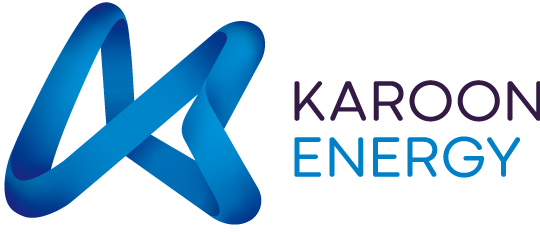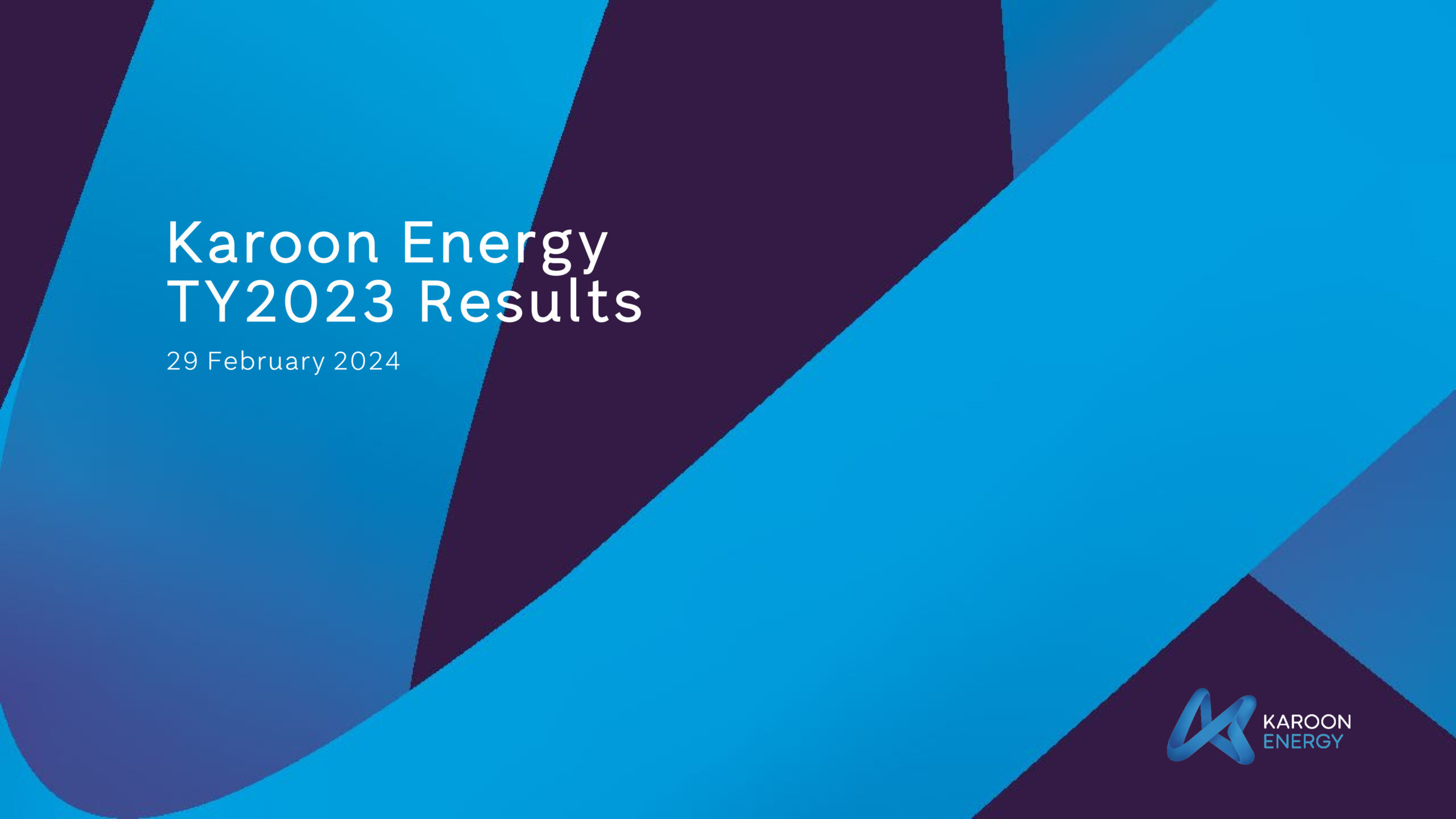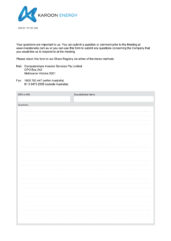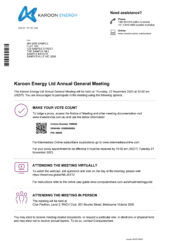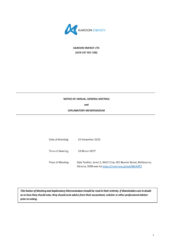Investors
ASX Releases
Karoon Energy Ltd Webcast – Transition Year 2023 Results
Tuesday, March 05, 2024Appendix 4G
Thursday, February 29, 2024Appendix 4E
Thursday, February 29, 2024Annual Report TY23
Thursday, February 29, 2024TY23 Corporate Governance Statement
Thursday, February 29, 2024Quarterly Reports
December 2023 Quarterly Report
Monday, January 29, 2024September 2023 Quarterly Report
Thursday, October 26, 2023June 2023 Quarterly Report
Thursday, July 27, 2023March 2023 Quarterly Report
Thursday, April 27, 2023December 2022 Quarterly Report
Tuesday, January 24, 2023September 2022 Quarterly Report and Appendix 5B
Thursday, October 27, 2022June 2022 Quarterly Report and Appendix 5B
Thursday, July 28, 2022March 2022 Quarterly Report and Appendix 5B
Thursday, April 28, 2022Half and Full Year Results
Transition Year Financial Report – TY23 – ASX Release & Investor Presentation
Thursday, February 29, 2024FY23 Full Year Results Announcement & Investor Presentation
Wednesday, August 23, 2023Karoon Energy FY23 Half Year Presentation
Wednesday, February 22, 2023Karoon Energy FY23 Half Year Results
Wednesday, February 22, 2023FY22 Full Year Results Investor Presentation
Thursday, August 25, 2022FY22 Full Year Results Announcement & Investor Presentation
Thursday, August 25, 2022FY22 Half Year Results Announcement & Investor Presentation
Wednesday, February 23, 2022FY22 Half Year Report and Accounts
Monday, February 21, 2022Feature Presentation
Presentations
Transition Year Financial Report – TY23 – ASX Release & Investor Presentation
Thursday, February 29, 2024Brazil Resources Conference
Friday, February 02, 2024Shaw & Partners Briefing Presentation
Thursday, January 18, 2024Macquarie UK Presentation
Monday, November 27, 2023AGM Webcast
Thursday, November 23, 2023Annual Reports
-
 2024 Annual Report
2024 Annual Report
-
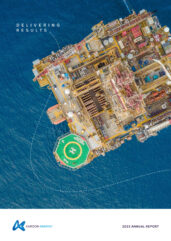 2023 Annual Report
2023 Annual Report
-
 2022 Annual Report
2022 Annual Report
-
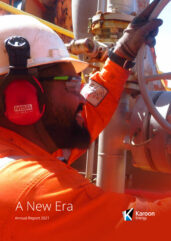 2021 Annual Report
2021 Annual Report
-
 2020 Annual Report
2020 Annual Report
-
 2019 Annual Report
2019 Annual Report
-
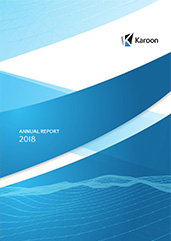 2018 Annual Report
2018 Annual Report
-
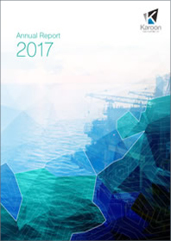 2017 Annual Report
2017 Annual Report
-
 2016 Annual Report
2016 Annual Report
-
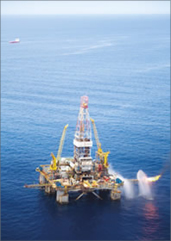 2015 Annual Report
2015 Annual Report
-
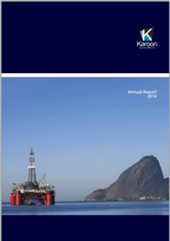 2014 Annual Report
2014 Annual Report
-
 2013 Annual Report
2013 Annual Report
-
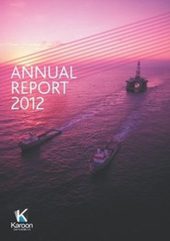 2012 Annual Report
2012 Annual Report
-
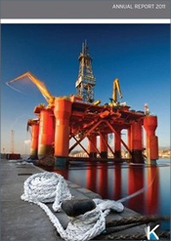 2011 Annual Report
2011 Annual Report
-
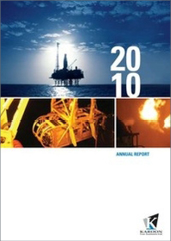 2010 Annual Report
2010 Annual Report
-
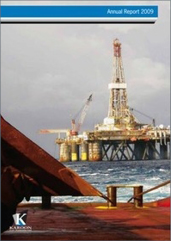 2009 Annual Report
2009 Annual Report
-
 2008 Annual Report
2008 Annual Report
-
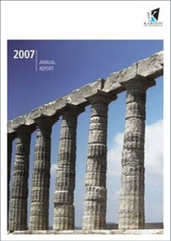 2007 Annual Report
2007 Annual Report
-
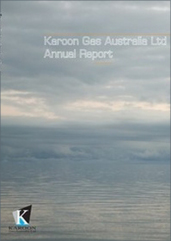 2006 Annual Report
2006 Annual Report
-
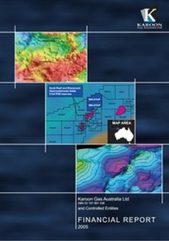 2005 Annual Report
2005 Annual Report
-
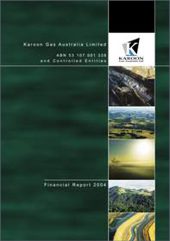 2004 Annual Report
2004 Annual Report
Annual Meetings
Financial Calendar
| Event | Date |
|---|---|
| December 2023 Quarter Results | Monday, 29 January 2024 |
| TY2023 Results | Thursday, 29 February 2024 |
| March 2024 Quarter Results | Wednesday, 24 April 2024 |
| TY2023 Annual General Meeting | Thursday, 23 May 2024 |
| June 2024 Quarter Results | Thursday, 25 July 2024 |
| FY2024 Half Year Results | Wednesday, 28 August 2024 |
| September 2024 Quarter Results | Thursday, 24 October 2024 |
| Note: All dates are subject to change |
Glossary and Conversions
Abbreviations
| m | Thousand |
| mm | Million |
| b | Billion |
| t | Trillion |
| k | kilo - 103 |
| M | Mega = 106 |
| G | Giga = 109 |
| T | Tera = 1012 |
| P | Peta = 1015 |
| bbl | Barrel |
| bpd | Barrels Per Day (Liquids) |
| bopd | Barrels of Oil Per Day |
| m bbls | Thousand Barrels |
| mm bbls | Million Barrels |
| boe | Barrel of Oil Equivalent |
| stb | Stock Tank Barrel |
| KL | Kilolitre |
| scf | Standard Cubic Feet |
| mscf | Thousand Standard Cubic Feet |
| mmscf | Million Standard Cubic Feet (106) |
| mmscfd | Million Standard Cubic Feet Per Day |
| mRT | Metres below the rotary table of the drilling rig |
| bcf | Billion Cubic Feet |
| bscf | Billion Standard Cubic Feet (109) |
| tcf | Trillion Cubic Feet |
| scm | Standard Cubic Metre |
| Btu | British Thermal Unit |
| J | Joule |
| Gj | Gigajoule 109 |
| TJ | Terajoule 1012 |
| PJ | Petajoule 1015 |
| T | Tonne |
| Kt | Thousand Tonnes |
| Tpa | Tonnes Per Annum |
| Toe | Tonne of Oil Equivalent |
Order terms
| APPEA | Australian Petroleum Production & Exploration Association |
| API | American Petroleum Institute (oil gravity) |
| AVO | Amplitude vs Offset (seismic analysis) |
| BOP | Blow out preventer |
| DCQ | Daily contract quantity |
| DHI | Direct Hydrocarbon Indicator (on seismic) |
| DST | Drill Stem Test |
| ESP | Electrical submersible pump |
| Feed | Front End Engineering and Design |
| FPSO | Floating Production, Storage & Offloading Unit |
| GOR | Gas oil ratio |
| GWC | Gas Water Contact |
| LOGS | Wireline logging tool (electronic, sonic, etc) |
| MDQ | Minimum Daily Quantity |
| NWSGP | North West Shelf Gas Project |
| OOIP | Original Oil in Place |
| OWC | Oil water contact |
| PRRT | Petroleum Resource Rent Tax |
| PSC | Production Sharing Contract |
| RFT | Repeat Formation Test |
| TVD | True Vertical Depth (of hole while drilling) |
| WTI | West Texas Intermediate (US benchmark oil) |
Industry standard boe
| 1 boe | 1 Barrel of Oil = 158.987 Litres | 170mm boe = 1 TCF | = 34.9726 Imperial gallons/42 US gallons | = 6,000 Cubic Feet Gas (Oil Search) | = 5,700 Cubic Feet Gas (Woodside) | = 0.1024 Tonnes LNG) | = 1.069 Barrels of Condensate | = 0.136 Tonnes of Condensate | = 1.3986 Barrels LPG | = 0.1182 Tonnes LPG (Cooper Basin) | = 0.1206 Tonnes of LPG (Bass Strait) | = 0.1134 Tonnes Propane | = 0.1293 Tonnes Butane | = 0.1908 Tonnes Coal |
| 1 Kilolitre | = 6.2898 Barrels |
| 1,000 bpd | = 50,000 tonnes per year |
| 100 mmcfd | = 36.5 bcf per year |
| 1 Tonne LNG | = 8.9055 boe (Woodside) | = 45.9 mcf | = 1,428 cm | = 51.7 Mbtu (Delivered) |
| 1 Cargo LNG (WPL NWS ships) = | = 56,000 Tonnes Delivered - (9th ship 62,000) |
| 1 million tonnes of LNG / year | = 3.65 million cubic metres of natural gas per day |
| 1 Tonne LPG | = 8.1876 boe (Woodside) |
| 1 Tonne LPG | = 8.458 boe (Santos) |
| ITJ | = 172 boe | = 163.6 boe (Woodside) | = 847 mcf (North West Shelf) | = 943 mcf (Cooper Basin) | = 948 mcf (Surat Basin) |
| 1 kilojoule | = 0.9478 btu |
| 1PJ | = 171,937 boe (Santos) |
| 1CF | = 1,000 Btu |
| 1 BCF | = 1.09 Pj | = 0.178428 mm boe |
| 1BCF | = 1.055 Petajoules (Santos& Oil Search) |
| 1 BTU | = 1.055 Kj |
| 1 mm Btu | = 0.1724 boe (Gulf of Mexico gas) | = 1 mcf |
| 1 cubic metres of gas | = 35.315 cubic feet or 35,315 BTU |
| 1 Tonne Ethane | = 26,800 cubic feet (Bass Strait) |
| 1 Tonne | = 8.3 bbls (Woodside) | = 7.35 bbls |
| 1 BBL Condensate/ Naphtha | = 0.935 boe (Santos) | = 1.0 boe (Woodside) |
SPE reserve definitions
Proved (1P) reserves:
Quantities of petroleum, which, by analysis of geoscience and engineering data, can be estimated with reasonable certainty to be commercially recoverable, from a given date forward, from known reservoirs under defined economic conditions, operating methods and government regulations. Probabilistic – at least 90% probability. Deterministic – high degree of confidence.
Probable (2P) reserves:
Additional reserves which analysis of geoscience and engineering data indicate are less likely to be recovered than proved reserves, but more certain to be recovered than possible reserves. It is equally likely that actual remaining quantities recovered will be greater than or less than the sum of the estimated proved plus probable reserves (2P). Probabilistic – at least 50% probability that quantities recovered will equal or exceed the 2P estimate.
Possible (3P) reserves:
Additional reserves which analysis of geoscience and engineering data suggest are less likely to be recoverable than probable reserves. The total quantities ultimately recovered from a project have a low probability to exceed the sum of provided plus probable plus possible (3P) reserves. Probabilistic – at least 10% probability that quantities recovered will equal or exceed the 3P estimate.
Probabilistic reserve definitions
P90. A probability cut-off of 90% is often used to describe proved reserves. In this case, proved reserves are defined as having a better-than-90% chance of being produced over the life of the field.
P50. A probability cut-off of 50% is often used to describe probable reserves. Reserves that have a better-than-50% chance of being technically and economically producible. These are reserves that are often referred to as ‘indicated’.
P10. A probability cut-off of 10% is often used to describe possible reserves. These are reserves that are often described as ‘inferred’. They have a less-than-50% chance of being technically and economically producible.
Proved reserves
The estimated quantities of crude oil, natural gas and natural gas liquids that geological and engineering data demonstrate with reasonable certainty to be recoverable in future years from known reservoirs under existing economic and operating conditions. Economic producibility must be supported by either actual production or conclusive formation test. The SEC allows 3Dseismic data to be used in the deep water Gulf of Mexico where high drilling costs prohibit full evaluation of a reservoir section.
Contingent reserve definition
Quantities of hydrocarbon estimated to be potentially recoverable from known accumulations, but are not currently considered to be commercially recoverable. Contingent resources may be of a significant size, but still have constraints to development. These constraints, preventing the booking of reserves, may relate to lack of gas marketing arrangements or to technical, environmental or political barriers that prevent current economic development.
Prospective resources
Those quantities of petroleum estimated, as of a given date, to be potentially recoverable from undiscovered accumulations by application of future development projects. This class represents a higher risk than contingent resources as the risk of discovery is also added.
